Feedlot Heart Disease
Congestive Heart Failure in Feedlots a Growing Concern
It's not just people who have to be worried about heart health. There is actually an increasing incidence of feedlot cattle affected by untreatable and fatal congestive heart failure.
The condition, feedlot heart disease (FHD), may be tied to selection over time of cattle for increased production levels, including in growth and marbling. As these production levels have increased, so too have incidences of FHD. Exact causes of FHD are unknown, however, making it difficult for those at the production level to make changes to address the issue moving forward.
With that in mind, the Foundation for Food and Agriculture Research's International Consortium for Antimicrobial Stewardship in Agriculture awarded a $433,720 grant to Colorado State University (CSU) and RTI LLC to help researchers find ways to identify FHA cattle and to reduce the risk for this disease.
Researchers hope to improve methods of identifying affected animals early enough to avoid treatment with antibiotics -- which are ineffective. They also hope to find genetics that may be underpinning the disease, and ultimately to develop mitigation strategies. Matching funds are being provided by Genus/ABS Global, Cactus Research, Veterinary Research and Consulting Services LLC and Hy-Plains Education and Research Center. That takes the total grant for FHD research close to the $1 million mark.
Symptoms connected with FHD may look like those for respiratory disease. But while respiratory disease will usually respond to antibiotic treatment, FHD does not. That makes identifying FHD animals early important both for their proper treatment, and to protect the future efficacy of available antibiotics.
Scott Speidel, a CSU researcher leading the team developing metrics to identify FHD cattle, reported that at this point, they think about 30% of animals in their study are experiencing FHD by the time they are harvested.
"This grant enables us to conduct critical research that has the potential to reduce feedlot mortality and improve overall animal welfare and performance," said Speidel. "It's a win-win in terms of enhancing animal welfare and supporting producers."
(c) Copyright 2021 DTN, LLC. All rights reserved.
P[L1] D[0x0] M[300x250] OOP[F] ADUNIT[] T[]





